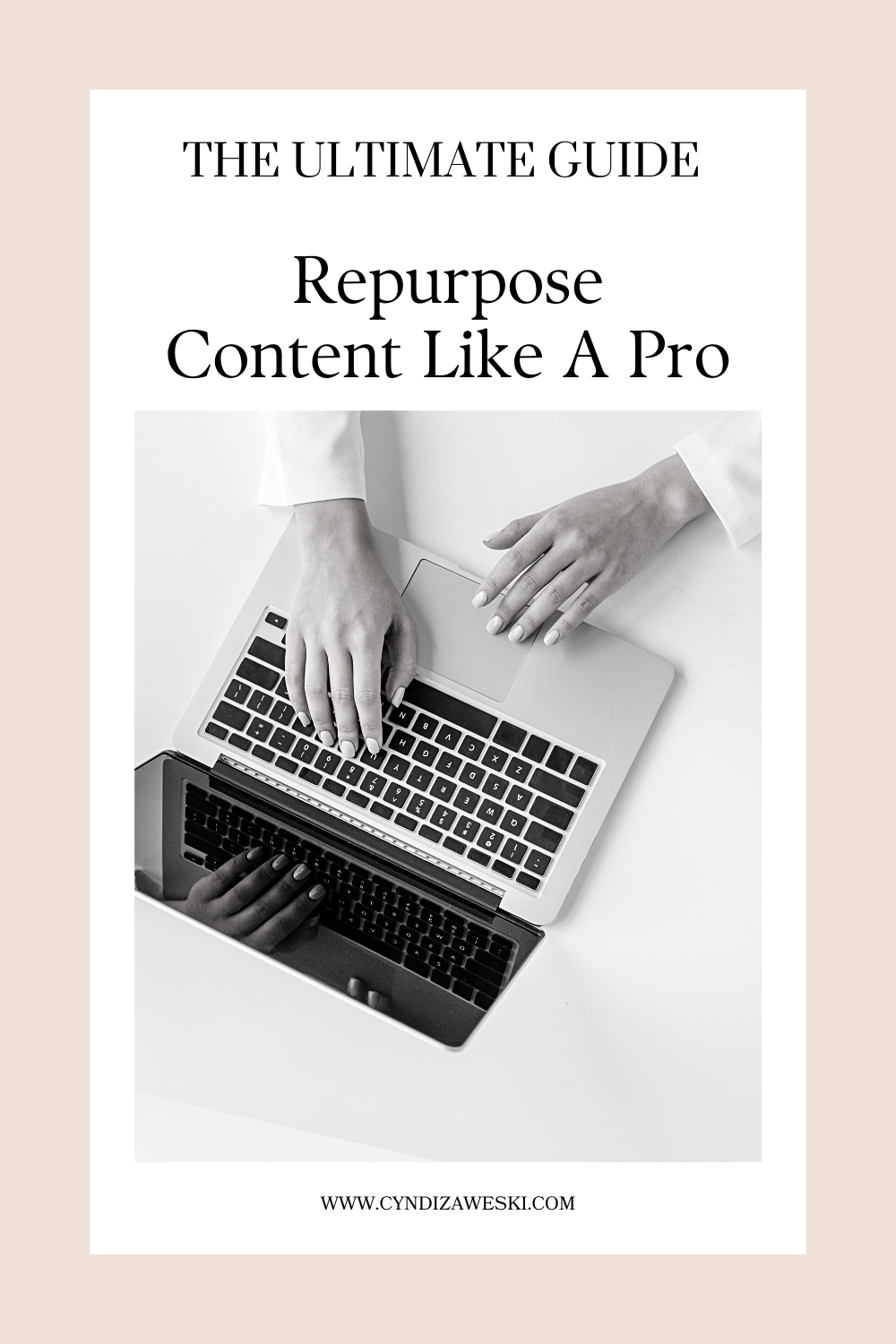How to Repurpose Content Like a Pro
Small business owners turned content creators have a lot on their plates. We’re under a lot of pressure to turn out high-quality content consistently across multiple platforms daily.
If you’re a solopreneur or the leader of a small, resourceful team, you know that there’s never enough time in the day to come up with content ideas, research your writing, find or create graphics, and hit publish — only do have to do it again tomorrow. Phew.
It is exhausting just thinking about the process.
If you're looking for ways to get more out of your content without having to create everything from scratch, then you're in the right place. Repurposing content is a smart and efficient way to create new content without having to start from scratch every time. It's all about taking existing content and transforming it into something new and fresh that can reach a wider audience or serve a different purpose.
In this post, I'll show you how to unlock the full potential of your content through repurposing.
What is Content Repurposing?
Content repurposing is the process of taking existing content and transforming it into something new and fresh that can reach a wider audience or serve a different purpose. Instead of creating new content from scratch every time, repurposing allows you to get more out of your existing content by presenting it in a different format or platform.
For example, turning a blog post into a video, or using social media posts to create an e-book or freebie.
PRO TIP: Keep repurposing ideas in the back of your mind when creating new content.
It helps to produce content with repurposing in mind, so you can easily slice and dice it into different formats. For example, if you’re recording a podcast, you might mark the time when a particularly good point was made. That point can then be turned into a separate social media post. The beauty of repurposing, after all, is getting more from what you already have.
The Benefits of Repurposing Content
Time is precious, which is why one massive benefit of repurposing content is the time it can save you in the content creation process, but it is not the only perk. The benefits of repurposing content include:
Improved SEO: Having multiple pieces of content around the same topic can generate additional opportunities to target the desired keyword, according to Buffer.
Wider Audience Reach: Different platforms appeal to different people. Having your content on multiple channels without stretching yourself thin allows you to reach more people with less stress.
Reinforcement of Your Marketing Message: Marketing’s Rule of 7 states that buyers need to hear your message seven times before they’ll close the deal. Repurposing goes a long way toward reaching this quota.
Establishing Expertise. Publishing quality content in various places on a single topic positions your brand as a go-to in the industry.
What Content Should You Repurpose?
You probably have a good idea of what content is a “greatest hit” for your business.
Analytics is the gold standard for determining your top-performing posts, but if you’re not that techy about it, a good indicator is a high engagement rate. If your audience commented, clicked, saved, and shared it several times, it provided value and is worth repurposing.
But what if it’s not so cut-and-dry?
Should You Repurpose Content That Didn't Perform Well?
Don't repurpose content *just* because you don't know what to post today.
Should you give a piece of content a second chance? Sometimes the answer is no!
Here is the ultimate strategy for knowing when and how to repurpose your content for maximum impact.
What if you're content didn't perform well but the message is on-brand and of value to your ideal audience? Repurpose it! Before repurposing ask, Can this information be written or presented better through a different content format or a snapper headline?
What if your content performed well but the message or topic isn't on-brand anymore? Then, maybe. Before repurposing ask, What about the message resonates with current and future content goals? Can it be tweaked to express your point in a way that will reach your goals?
How To Repurpose Content
Here is a step-by-step guide to repurpose content:
1. Audit your existing content: Take an inventory of your existing content and identify pieces that can be repurposed. Look for content that is evergreen, high-performing, or relevant to your current goals. (See above for pointers on what content is worth repurposing).
Example: Take inspiration from a blog post for a YouTube video. If someone wants to read about a topic, they’ll probably be interested in watching a video about it, too. Pro tip: your blog post is the basis for the script of the video.
2. Determine your goals: Decide what you want to achieve with your repurposed content. Are you trying to reach a new audience, drive traffic to your website, or promote a new product or service?
3. Choose a new format: Decide which format will best suit your goals and audience. Consider turning a blog post into a video, podcast, or infographic. Or, use social media posts to create an e-book or white paper.
4. Optimize the content: Repurpose the content to fit the new format and platform. For example, if you're creating a video from a blog post, you may need to add visuals or adjust the tone to fit the medium. Or, it can be as simple as changing the headline.
5. Promote the repurposed content: Lastly, get it on your content calendar. Once you've created your repurposed content, promote it across your social media channels, email list, and website.
This will help you reach a wider audience and drive more traffic to your website.
Steal A Page From My Repurposing Playbook
You don’t need to go from one big piece of content into several small ones. One of my favorite ways to repurpose my Instagram captions is to reverse engineer an entire blog post.
For example, I post a lot of small business content strategy tips. My captions are well researched and include a lot of quick wins. Instead of limiting it to my Instagram audience, I created a blog about content marketing by combining multiple captions.
Posting it to my website allows me to reach more people interested in upping their content marketing game, plus it improves SEO. Then I turn that blog into Pinterest pins and Facebook posts. It’s the gift that keeps on giving.
Read more about How to Turn Instagram Posts into a Blog
12 Ways To Repurpose Instagram Content
Repurpose a Carousel Post: Repost a high-performing carousel post with a fresh & spicy headline.
Repurpose a Carousel Post: Use the key points to inform a tutorial Reel. Simply use the graphic text as a script.
Repurpose a Carousel Post: Mash up two high-performing carousel posts on the same topic into one super post.
Repurpose a Carousel Post: Turn it into the outline of a new lead magnet.
Repurpose a Carousel Post: Think of it as a first draft for a Linkedin Article.
Repurpose a Reel: Same video. Different trending sounds. Works well with "yes" and "no" audio.
Repurpose a Reel: Was it funny and relatable? Make it a meme.
Was it a tutorial? Make it a blog or carousel.
Make it an Idea Pin. Use this handy tool to convert Reels (audio and all) into Idea Pins for Pinterest. Note: Lip-syncing Reels don't often translate well to Pinterest but straight-to-the-camera tutorials perform well. Experiment!
Repurpose a Static Post: Use it as a Pinterest Pin. Link to your Instagram post if you don't have a blog.
Repurpose a Static Post: Stuck on what to send your email list? Embed your Instagram images into your newsletter.
Repurpose a Static Post: Blogs with images perform better. Embed a static post into a relevant blog.
ACE Model For Repurposing Content
Content repurposing doesn't just mean that you reuse an old piece of content again and again. Great repurposing — that increases your SEO and brand awareness — builds and expands on itself over time.
Like a fine wine, your content can get better with age.
This is how the simple and aptly named A.C.E method will help you ace your repurposing strategy — pun very much intended.
A is For Adjust: Ask Yourself What Needs to be Added, Removed, or Re-Worded?
C is Combine: Where Can You Combine Related Content to Provide New Value and Meaning?
E is for Expand: Is there an Opportunity to Expand on Something You've Already Done to Dig Deeper into the Topic?
Through repurposing, you can reach a wider audience, improve your search engine rankings, and save time and resources.
Whether you choose to convert your blog posts into different formats or update them with new information, repurposing your content can help you get more mileage out of your efforts.
Happy Creating!
Cyndi, Owner of Ascent StoryCraft
Let’s Get Social! Connect with me on: Instagram Or Get More Like This To Your Inbox 📥




